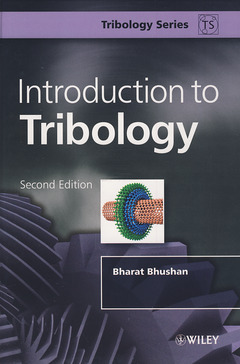Description
Introduction to Tribology (2nd Ed.)
Tribology in Practice Series
Author: Bhushan Bharat
Language: English
Subjects for Introduction to Tribology:
744 p. · 15.6x24.4 cm · Hardback
Description
/li>Contents
/li>Biography
/li>
A fully updated version of the popular Introduction to Tribology, the second edition of this leading tribology text introduces the major developments in the understanding and interpretation of friction, wear and lubrication. Considerations of friction and wear have been fully revised to include recent analysis and data work, and friction mechanisms have been reappraised in light of current developments.
In this edition, the breakthroughs in tribology at the nano- and micro- level as well as recent developments in nanotechnology and magnetic storage technologies are introduced. A new chapter on the emerging field of green tribology and biomimetics is included.
- Introduces the topic of tribology from a mechanical engineering, mechanics and materials science points of view
- Newly updated chapter covers both the underlying theory and the current applications of tribology to industry
- Updated write-up on nanotribology and nanotechnology and introduction of a new chapter on green tribology and biomimetics
About the Author xv
Foreword xvii
Series Preface xix
Preface to the Second Edition xxi
Preface to the First Edition xxiii
1 Introduction 1
1.1 Definition and History of Tribology 1
1.2 Industrial Significance of Tribology 3
1.3 Origins and Significance of Micro/Nanotribology 4
1.4 Organization of the Book 6
2 Solid Surface Characterization 9
2.1 The Nature of Surfaces 9
2.2 Physico-Chemical Characteristics of Surface Layers 10
2.3 Analysis of Surface Roughness 14
2.4 Measurement of Surface Roughness 51
2.5 Closure 84
3 Contact Between Solid Surfaces 91
3.1 Introduction 91
3.2 Analysis of the Contacts 92
3.3 Measurement of the Real Area of Contact 146
3.4 Closure 150
4 Adhesion 157
4.1 Introduction 157
4.2 Solid–Solid Contact 158
4.3 Liquid-Mediated Contact 172
4.4 Closure 194
5 Friction 199
5.1 Introduction 199
5.2 Solid–Solid Contact 201
5.3 Liquid-Mediated Contact 236
5.4 Friction of Materials 239
5.5 Closure 264
6 Interface Temperature of Sliding Surfaces 273
6.1 Introduction 273
6.2 Thermal Analysis 274
6.3 Interface Temperature Measurements 298
6.4 Closure 309
7 Wear 315
7.1 Introduction 315
7.2 Types of Wear Mechanism 316
7.3 Types of Particles Present in Wear Debris 365
7.4 Wear of Materials 369
7.5 Closure 388
8 Fluid Film Lubrication 399
8.1 Introduction 399
8.2 Regimes of Fluid Film Lubrication 400
8.3 Viscous Flow and Reynolds Equation 404
8.4 Hydrostatic Lubrication 418
8.5 Hydrodynamic Lubrication 428
8.6 Elastohydrodynamic Lubrication 481
8.7 Closure 493
9 Boundary Lubrication and Lubricants 501
9.1 Introduction 501
9.2 Boundary Lubrication 501
9.3 Liquid Lubricants 511
9.4 Greases 520
9.5 Closure 521
10 Nanotribology 525
10.1 Introduction 525
10.2 SFA Studies 527
10.3 AFM/FFM Studies 538
10.4 Atomic-Scale Computer Simulations 598
10.5 Closure 602
11 Friction and Wear Screening Test Methods 615
11.1 Introduction 615
11.2 Design Methodology 615
11.3 Typical Test Geometries 619
11.4 Closure 628
12 Tribological Components and Applications 631
12.1 Introduction 631
12.2 Common Tribological Components 631
12.3 MEMS/NEMS 644
12.4 Material Processing 656
12.5 Industrial Applications 662
12.6 Closure 676
13 Green Tribology and Biomimetics 683
13.1 Introduction 683
13.2 Green Tribology 683
13.3 Biomimetics 689
13.4 Closure 693
References 694
Further Reading 696
AppendixA Units, Conversions, and Useful Relations 697
A.1 Fundamental Constants 697
A.2 Conversion of Units 698
A.3 Useful Relations 698
Index 701
These books may interest you

Nano-tribology and Materials in MEMS 105.49 €

Nano-tribology and Materials in MEMS 105.49 €


